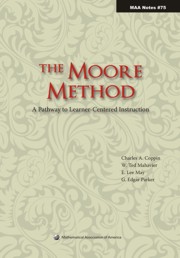Book contents
- Frontmatter
- Contents
- Dedication
- Acknowledgements
- 1 Introduction
- 2 Moore's Moore Method
- 3 What is the Moore Method?
- 4 On Culture
- 5 Development and Selection of Materials
- 6 In the Classroom
- 7 Grading
- 8 Why Use the Moore Method?
- 9 Evaluation and Assessment: Effectiveness of the Method
- 10 Frequently Asked Questions
- Appendices
- About the Authors
- References
- Index
7 - Grading
- Frontmatter
- Contents
- Dedication
- Acknowledgements
- 1 Introduction
- 2 Moore's Moore Method
- 3 What is the Moore Method?
- 4 On Culture
- 5 Development and Selection of Materials
- 6 In the Classroom
- 7 Grading
- 8 Why Use the Moore Method?
- 9 Evaluation and Assessment: Effectiveness of the Method
- 10 Frequently Asked Questions
- Appendices
- About the Authors
- References
- Index
Summary
“The men who try to do something and fail are infinitely better than those who try to do nothing and succeed.”
—Martin Lloyd Jones, Welsh Theologian, 1899–1981Each of the coauthors places a high emphasis on the presentation of material, with the lowest percentage listed by any author being twenty-five percent of the final grade. While each author outlines a grading scheme that appears, on the surface, to be distinct from the others, all the formulae ensure that those students who create a significant amount of original (to the students) mathematics receive an A. Those students who do not create mathematics, but successfully reproduce the mathematics presented in class by the end of the course, receive at least a D. All strive to allow the students the maximum time to achieve the goal of producing mathematics; in each case this is at least to the end of the class meetings and in several cases to the end of the final examination. It seems as if they would like it to extend even farther, but the timeline for grades associated with semesters or quarters prevents a longer wait. Each system evaluates students' written work and each system asks students to demonstrate, at the very least, the ability to write correct mathematics on at least one examination. Each author recognizes the subjective nature of grading in a global sense and strives to be objective in assessing student performance by considering numerous factors such as difficulty of the problems attempted, quality of the presentations, facility in responding to questions about the work, and the posing of additional conjectures.
- Type
- Chapter
- Information
- The Moore MethodA Pathway to Learner-Centered Instruction, pp. 99 - 118Publisher: Mathematical Association of AmericaPrint publication year: 2009



